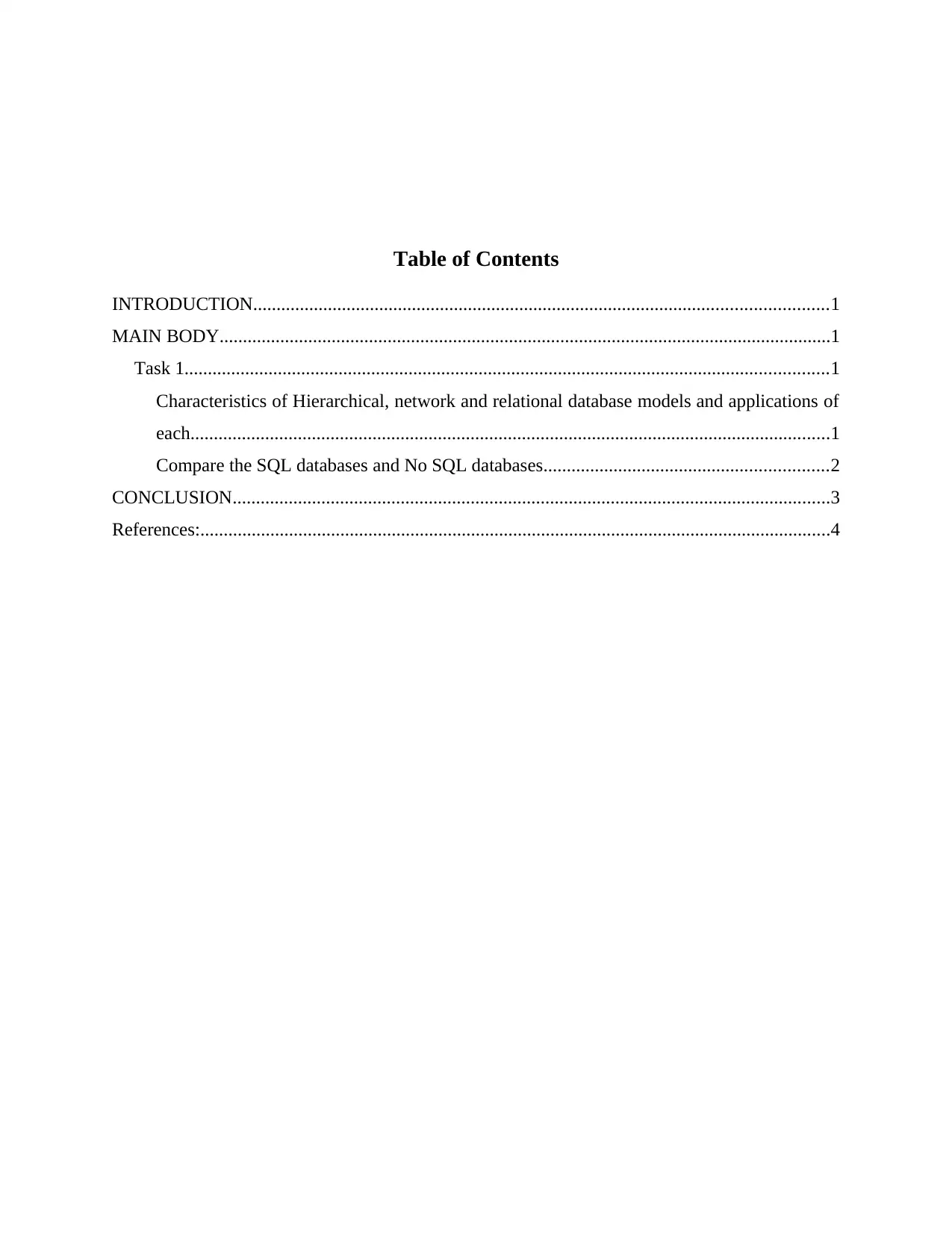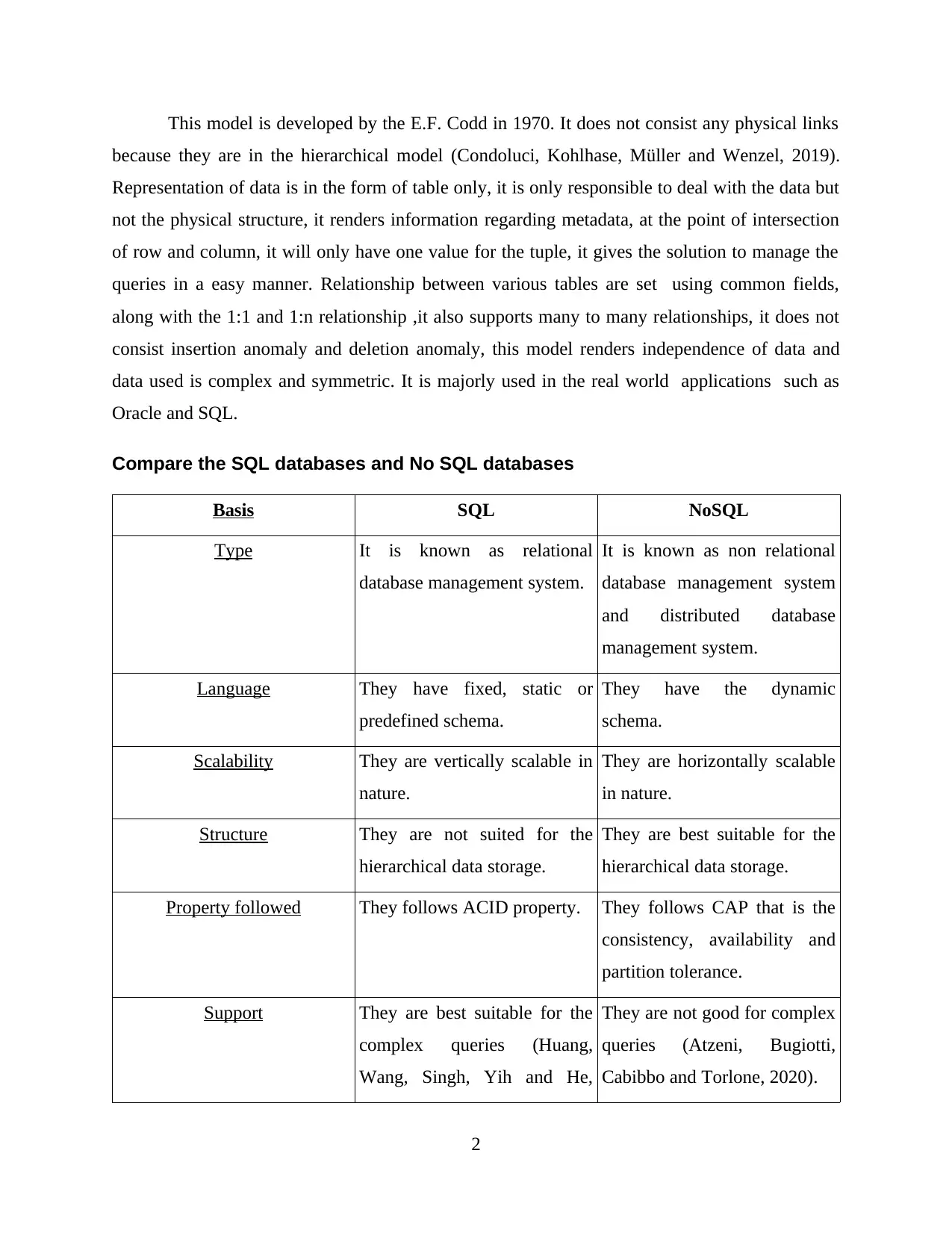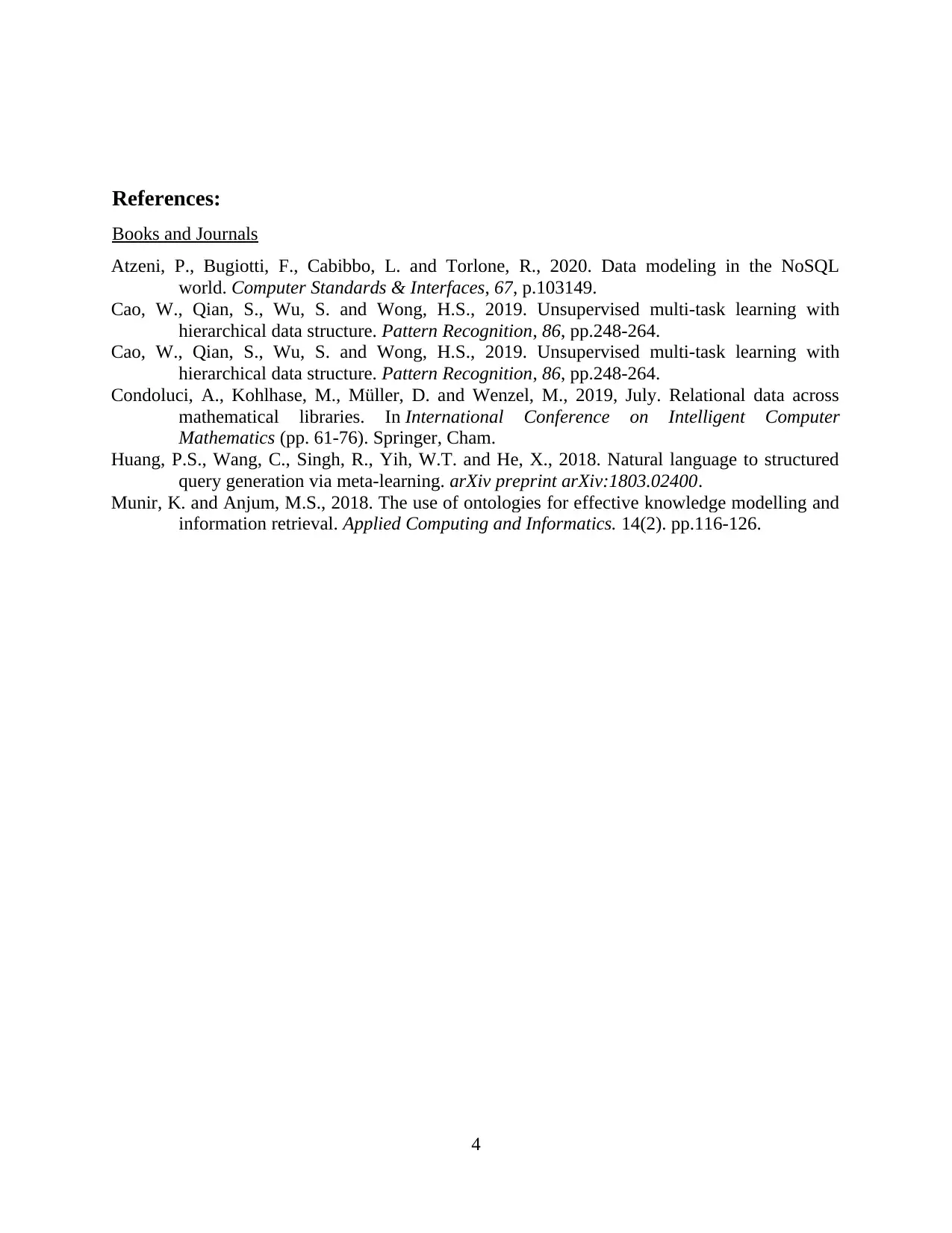Characteristics of Hierarchical, Network, and Relational Database Models
VerifiedAdded on 2022/12/26
|6
|1056
|44
AI Summary
This article discusses the characteristics of hierarchical, network, and relational database models and their applications. It also compares SQL and NoSQL databases.
Contribute Materials
Your contribution can guide someone’s learning journey. Share your
documents today.

Data Modelling and
SQL Language
SQL Language
Secure Best Marks with AI Grader
Need help grading? Try our AI Grader for instant feedback on your assignments.

Table of Contents
INTRODUCTION...........................................................................................................................1
MAIN BODY...................................................................................................................................1
Task 1..........................................................................................................................................1
Characteristics of Hierarchical, network and relational database models and applications of
each.........................................................................................................................................1
Compare the SQL databases and No SQL databases.............................................................2
CONCLUSION................................................................................................................................3
References:.......................................................................................................................................4
INTRODUCTION...........................................................................................................................1
MAIN BODY...................................................................................................................................1
Task 1..........................................................................................................................................1
Characteristics of Hierarchical, network and relational database models and applications of
each.........................................................................................................................................1
Compare the SQL databases and No SQL databases.............................................................2
CONCLUSION................................................................................................................................3
References:.......................................................................................................................................4

INTRODUCTION
Data modelling can be defined as the building up of a data model for the data that is
required to be captured in a database. It is an abstract execution of data objects, the relations
between various data objects and the rules associated with it (Munir and Anjum, 2018).
Therefore, the following discussion is made on the characteristics of hierarchical, network and
relational database models and the difference between SQL and NOSQL database management
system with proper conclusion.
MAIN BODY
Task 1
Characteristics of Hierarchical, network and relational database models and
applications of each
Hierarchical database models
It is known as the most oldest type of the data model and developed by IBM in 1968
(Cao, Qian, Wu and Wong, 2019). It organises data in the form of three like structure and it has
the following characteristics: it consist nodes that are connected by various branches, top most
node is the root node, multiple nodes are known as the root segments, each node contains exactly
one parent, one parent can have many many child, it executes 1:1 and 1:n relations, child node
cannot be inserted without a parent node, it is difficult to erase the parent node, it lacks
independence of data and data uses is complex and asymmetric. &XML and XAML use this
model.
Network database models
It is known as the advanced version of the hierarchical data model because it uses
directed graphs instead of the three structure method (Cao, Qian, Wu and Wong, 2019). It consist
child more than one parent therefore it uses the conception of two data structure such as records
and sets. It manages records using links or pointers to one another, along with 1:1 and 1:n, it
also executes many to many relationships, it does not have any insertion anomaly and deletion
anomaly, it consist partial data independence and data used in this model is complex and
symmetric. VAX-DBMS, DMS-1100 of UNIVAC and SUPRADBMS's use this model.
Relational database models
1
Data modelling can be defined as the building up of a data model for the data that is
required to be captured in a database. It is an abstract execution of data objects, the relations
between various data objects and the rules associated with it (Munir and Anjum, 2018).
Therefore, the following discussion is made on the characteristics of hierarchical, network and
relational database models and the difference between SQL and NOSQL database management
system with proper conclusion.
MAIN BODY
Task 1
Characteristics of Hierarchical, network and relational database models and
applications of each
Hierarchical database models
It is known as the most oldest type of the data model and developed by IBM in 1968
(Cao, Qian, Wu and Wong, 2019). It organises data in the form of three like structure and it has
the following characteristics: it consist nodes that are connected by various branches, top most
node is the root node, multiple nodes are known as the root segments, each node contains exactly
one parent, one parent can have many many child, it executes 1:1 and 1:n relations, child node
cannot be inserted without a parent node, it is difficult to erase the parent node, it lacks
independence of data and data uses is complex and asymmetric. &XML and XAML use this
model.
Network database models
It is known as the advanced version of the hierarchical data model because it uses
directed graphs instead of the three structure method (Cao, Qian, Wu and Wong, 2019). It consist
child more than one parent therefore it uses the conception of two data structure such as records
and sets. It manages records using links or pointers to one another, along with 1:1 and 1:n, it
also executes many to many relationships, it does not have any insertion anomaly and deletion
anomaly, it consist partial data independence and data used in this model is complex and
symmetric. VAX-DBMS, DMS-1100 of UNIVAC and SUPRADBMS's use this model.
Relational database models
1

This model is developed by the E.F. Codd in 1970. It does not consist any physical links
because they are in the hierarchical model (Condoluci, Kohlhase, Müller and Wenzel, 2019).
Representation of data is in the form of table only, it is only responsible to deal with the data but
not the physical structure, it renders information regarding metadata, at the point of intersection
of row and column, it will only have one value for the tuple, it gives the solution to manage the
queries in a easy manner. Relationship between various tables are set using common fields,
along with the 1:1 and 1:n relationship ,it also supports many to many relationships, it does not
consist insertion anomaly and deletion anomaly, this model renders independence of data and
data used is complex and symmetric. It is majorly used in the real world applications such as
Oracle and SQL.
Compare the SQL databases and No SQL databases
Basis SQL NoSQL
Type It is known as relational
database management system.
It is known as non relational
database management system
and distributed database
management system.
Language They have fixed, static or
predefined schema.
They have the dynamic
schema.
Scalability They are vertically scalable in
nature.
They are horizontally scalable
in nature.
Structure They are not suited for the
hierarchical data storage.
They are best suitable for the
hierarchical data storage.
Property followed They follows ACID property. They follows CAP that is the
consistency, availability and
partition tolerance.
Support They are best suitable for the
complex queries (Huang,
Wang, Singh, Yih and He,
They are not good for complex
queries (Atzeni, Bugiotti,
Cabibbo and Torlone, 2020).
2
because they are in the hierarchical model (Condoluci, Kohlhase, Müller and Wenzel, 2019).
Representation of data is in the form of table only, it is only responsible to deal with the data but
not the physical structure, it renders information regarding metadata, at the point of intersection
of row and column, it will only have one value for the tuple, it gives the solution to manage the
queries in a easy manner. Relationship between various tables are set using common fields,
along with the 1:1 and 1:n relationship ,it also supports many to many relationships, it does not
consist insertion anomaly and deletion anomaly, this model renders independence of data and
data used is complex and symmetric. It is majorly used in the real world applications such as
Oracle and SQL.
Compare the SQL databases and No SQL databases
Basis SQL NoSQL
Type It is known as relational
database management system.
It is known as non relational
database management system
and distributed database
management system.
Language They have fixed, static or
predefined schema.
They have the dynamic
schema.
Scalability They are vertically scalable in
nature.
They are horizontally scalable
in nature.
Structure They are not suited for the
hierarchical data storage.
They are best suitable for the
hierarchical data storage.
Property followed They follows ACID property. They follows CAP that is the
consistency, availability and
partition tolerance.
Support They are best suitable for the
complex queries (Huang,
Wang, Singh, Yih and He,
They are not good for complex
queries (Atzeni, Bugiotti,
Cabibbo and Torlone, 2020).
2
Secure Best Marks with AI Grader
Need help grading? Try our AI Grader for instant feedback on your assignments.

2018).
CONCLUSION
It is concluded that data modelling is an important concept to study to better understand
the conception of the database management systems. Therefore, it is essential to analyse the
characteristics of hierarchical, network and relational database models and applications of each
and it is significant to compare the SQL databases and No SQL databases. Hence, this report
covers all such areas for enhancement in the gaining of knowledge of it so that it can be applied
in a real world applications.
3
CONCLUSION
It is concluded that data modelling is an important concept to study to better understand
the conception of the database management systems. Therefore, it is essential to analyse the
characteristics of hierarchical, network and relational database models and applications of each
and it is significant to compare the SQL databases and No SQL databases. Hence, this report
covers all such areas for enhancement in the gaining of knowledge of it so that it can be applied
in a real world applications.
3

References:
Books and Journals
Atzeni, P., Bugiotti, F., Cabibbo, L. and Torlone, R., 2020. Data modeling in the NoSQL
world. Computer Standards & Interfaces, 67, p.103149.
Cao, W., Qian, S., Wu, S. and Wong, H.S., 2019. Unsupervised multi-task learning with
hierarchical data structure. Pattern Recognition, 86, pp.248-264.
Cao, W., Qian, S., Wu, S. and Wong, H.S., 2019. Unsupervised multi-task learning with
hierarchical data structure. Pattern Recognition, 86, pp.248-264.
Condoluci, A., Kohlhase, M., Müller, D. and Wenzel, M., 2019, July. Relational data across
mathematical libraries. In International Conference on Intelligent Computer
Mathematics (pp. 61-76). Springer, Cham.
Huang, P.S., Wang, C., Singh, R., Yih, W.T. and He, X., 2018. Natural language to structured
query generation via meta-learning. arXiv preprint arXiv:1803.02400.
Munir, K. and Anjum, M.S., 2018. The use of ontologies for effective knowledge modelling and
information retrieval. Applied Computing and Informatics. 14(2). pp.116-126.
4
Books and Journals
Atzeni, P., Bugiotti, F., Cabibbo, L. and Torlone, R., 2020. Data modeling in the NoSQL
world. Computer Standards & Interfaces, 67, p.103149.
Cao, W., Qian, S., Wu, S. and Wong, H.S., 2019. Unsupervised multi-task learning with
hierarchical data structure. Pattern Recognition, 86, pp.248-264.
Cao, W., Qian, S., Wu, S. and Wong, H.S., 2019. Unsupervised multi-task learning with
hierarchical data structure. Pattern Recognition, 86, pp.248-264.
Condoluci, A., Kohlhase, M., Müller, D. and Wenzel, M., 2019, July. Relational data across
mathematical libraries. In International Conference on Intelligent Computer
Mathematics (pp. 61-76). Springer, Cham.
Huang, P.S., Wang, C., Singh, R., Yih, W.T. and He, X., 2018. Natural language to structured
query generation via meta-learning. arXiv preprint arXiv:1803.02400.
Munir, K. and Anjum, M.S., 2018. The use of ontologies for effective knowledge modelling and
information retrieval. Applied Computing and Informatics. 14(2). pp.116-126.
4
1 out of 6
Related Documents
Your All-in-One AI-Powered Toolkit for Academic Success.
+13062052269
info@desklib.com
Available 24*7 on WhatsApp / Email
![[object Object]](/_next/static/media/star-bottom.7253800d.svg)
Unlock your academic potential
© 2024 | Zucol Services PVT LTD | All rights reserved.





